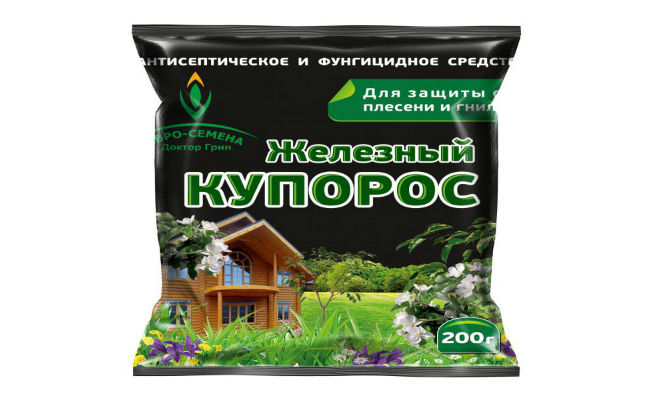In the arsenal of a farmer there is a proven, reliable drug - iron sulfate. It is still in demand, despite the emergence of many new chemicals. The reasons for the popularity: a wide range of applications, low toxicity, reasonable price. What kind of drug it is, how to dilute it and then treat the garden, we will tell further.
Table of contents
The composition and release form of iron sulfate
Iron sulfate is otherwise called ferrous sulphate. From a chemical point of view, it is a salt, ferrous sulphate. It looks like small crystals (sometimes - powder) of a greenish color with a bluish (turquoise) or yellowish tinge.
Iron sulfate is sold in garden and hardware stores, retail packaging is usually 200 or 250 g. The mass fraction of the beneficial substance (sulfate) is 53% (grade 1) or 47% (grade 2); in terms of pure iron - 20%.
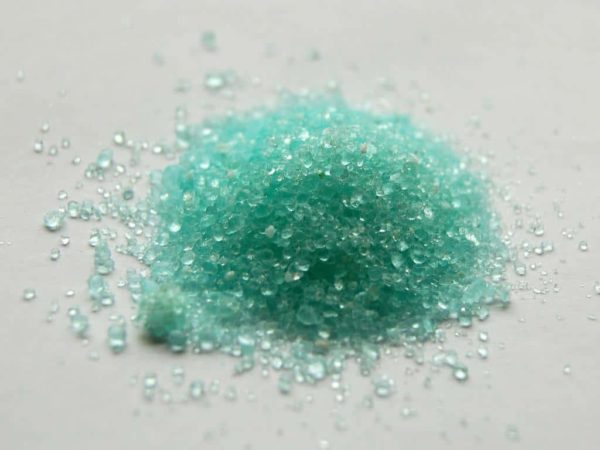
Preparation of the working solution (general rules)
An aqueous solution of ferrous sulphate in different concentrations in horticulture is in demand. It is applied using a spray gun, in some cases - with a brush. To prepare it is very simple.
Water for breeding is desirable to take soft - rain or snow. The resulting liquid is an antiseptic, has an acid reaction.
Compatibility with other drugs
When iron sulphate is mixed with alkalis (for example, with lime), chemical interaction occurs, and many properties are neutralized and lost. But such mixtures are sometimes used in agriculture as moderate (soft) fungicides.
It is not recommended to combine ferrous sulfate with other fungicides, with malathion-based insecticides (Karbofos, Fufanon, Aliot, Iskra M, Alatar, Inta-CM).
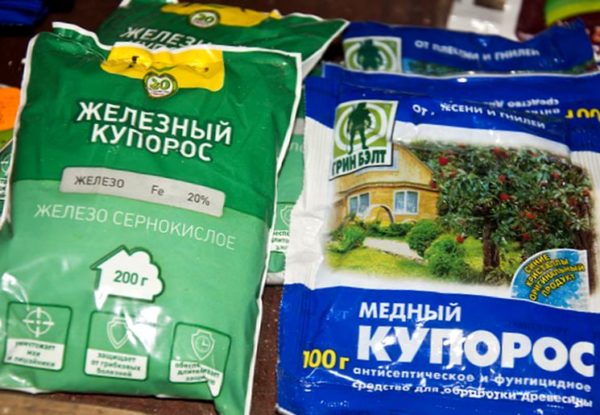
Dosage
The solution of ferrous sulfate is prepared in various concentrations (proportion to 10 liters of water):
- 15% - 1.5 kg;
- 10% - 1 kg;
- 5% - 500 g;
- 3% - 300 g;
- 1% - 100 g;
- 0.5% - 50 g
Concentration of more than 1% is very effective, but it burns greens and is suitable only for plants in the resting stage.
Spheres of application
Blue vitriol helps fight some pests and plant diseases, fungus in homes and cellars. Acts as a fertilizer for chlorosis. Solves the following tasks:
- Destruction of lichens and mosses in garden plantings.
- Disinfection of wood wounds, hollow.
- Suppression of fungal infections in fruit, berry, ornamental and vegetable crops (treatment and prevention). Protection contact, on a surface (without penetration in plants).
- Decrease in the number of some insects (apple squirrel, pests of grapes).
- The reflection of the attack of rodents (efficiency - not 100%).
- Filling up the lack of iron in plant nutrition.
- Cleaning the walls of fungus, mold in the cellar and in the house. Wood processing.
- Disinfection of country toilets.
Consider various methods in more detail.
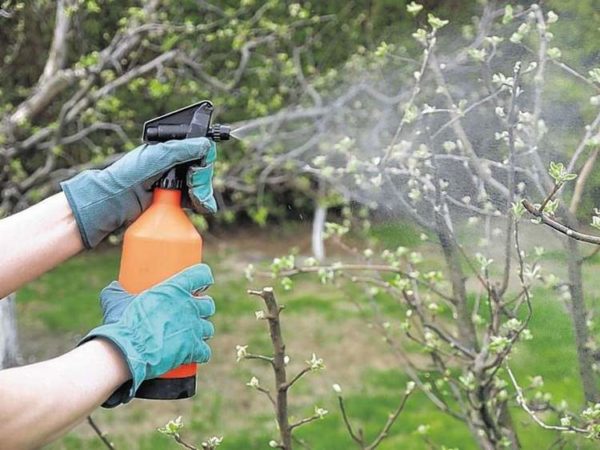
Work instruction
In each case, need different concentrations. Let's look at the instructions and how it differs for different trees and shrubs.
When filling the hollow
Closing the hollow on the fruit tree allows you to stop the destruction of wood and extend the life of the plant. The operation is carried out at the end of the season, after leaf fall, in stages:
- cleaning the internal cavity to healthy wood;
- disinfection with iron vitriol (5 percent); sometimes recommend a stronger version (10%);
- after 4 hours - sealing (filling) with cement mortar (cement, sand, lime in a ratio of 2: 6: 1 plus water until creamy thickness);
- after drying - coating paint on linseed oil.
How to treat wounds in the fall trees
Cold masks, burns, mechanical and infectious damage to the bark and wood are treated with ferrous sulfate (5%) after cutting out dead tissue. The optimal time for such events is the first half of summer.
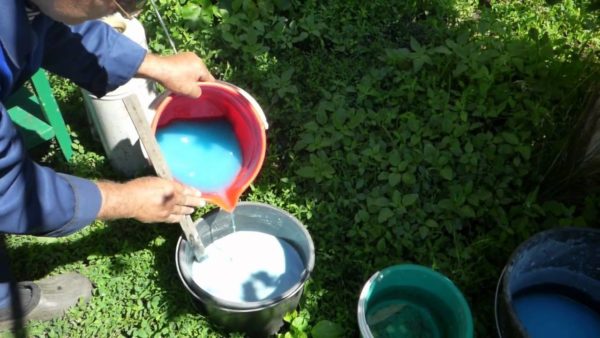
Autumn sprinkling in gardening
After leaf fall trees and bushes enter the rest phase. This is the best time for a concentrated strike:
- for fungal diseases (coccomycosis, cytosporosis, septoria, black cancer, scab, moniliosis, powdery mildew, anthracnose, spotting, rust, botrytis, etc.);
- on mosses and lichens.
Dosage for the garden:
- pomes rocks (apple, pear, etc.) - 5%.
- stone fruit (cherry, plum, etc.) and decorative cultures (including roses), berries (raspberry, currant, gooseberry) - 3%.
The treatment is carried out by abundant spraying of trunks and branches, as well as pristvolny circles and soil in the adjacent territory. Approximate consumption - 2 liters per plant. They operate at positive air temperature (from +5) in calm and clear weather.
Treatment in spring (before bud swelling)
Spring event - analogue of the autumn: same rules (not recommended for roses only). You can not be late with the deadlines: work when setting low positive temperatures (+5 degrees or slightly higher), strictly on sleeping buds. If the currant is already awake, it does not touch.
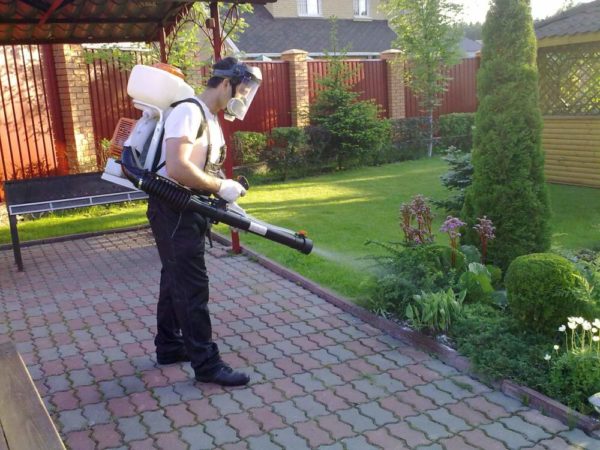
Such a spraying of apple trees in the spring reduces the number of the harmful insect - the apple leafblock (creeper).
Program for grapes
- Cuttings in the fall are disinfected before winter storage (3%).
- Sleeping cuttings before spring planting are washed with a solution of ferrous sulfate (1%). The kidneys are “inhibited”, contributing to the growth of the roots.
- In autumn, the young vine planted for wintering before the shelter is treated at a concentration of 3%, adult bushes - 5%. Consumption - from 1 to 3 liters per bush. After some time, if the weather is wet, the vines darken - this is a normal reaction.
- Work is repeated in the spring, after opening, at air temperatures above +4 degrees, before bud break. Sometimes for the spring, a concentration is recommended weaker - 1%.
Many diseases and pests of the vineyards are suppressed - oidium, pillow, mealybug, etc. Along the way, the procedure holds back the opening of the kidneys for 1-2 weeks (sometimes it is useful for avoiding frost).
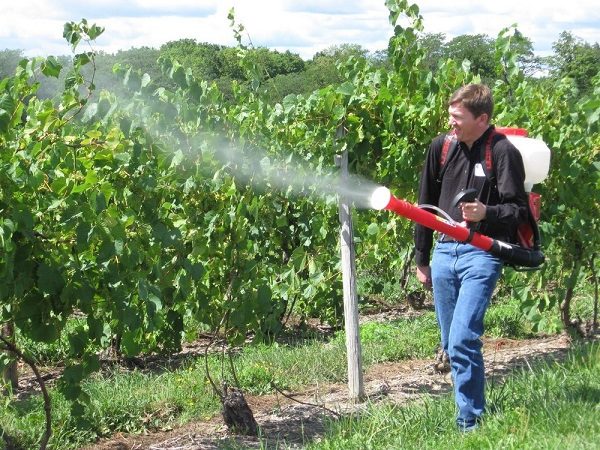
Special blend
To fight fungal diseases, a special substance has to be prepared on a green sheet (it has a scientific patent, it has been tested). Mix 50 g of ferrous sulfate, 30 g of urea, 20 g of hydrated lime and 10 liters of water. The prepared liquid is stored no longer than a day. Sprayed:
- apples, plums, cherries in the stage of bud break;
- strawberries in spring in the growth phase of young foliage;
- tomatoes, potatoes during the growing season (less phytophtoras and the Colorado potato beetle).
Additional effects:
- the acidity of the substance is close to neutral, does not burn;
- toxicity is minimal;
- components enhance the action of each other;
- good adhesion, long lasting protection;
- nutritional value (nitrogen, iron, calcium).
Observed quantitative growth of the crop, improving its quality.
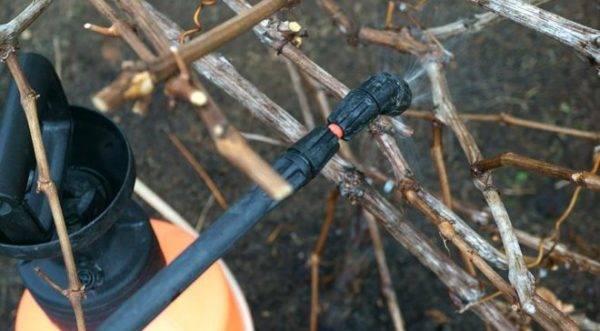
Seasonal protection of roses in the garden
To combat black spot on roses, they are sprayed with foliar sulfate iron (diluted in a concentration of from 0.5 to 1%, not more): starting from the end of spring - several times (with an interval of 13 days).
Fertilizer fruit trees
If there is a shortage of iron, the plants show signs of chlorosis (yellowing, blanching) on the young leaves, the old leaf remains green; flowers are shrinking.Apple trees are especially sensitive - they have young shoots. On grassy crops, chlorosis occurs when excessive irrigation of the land with potassium permanganate (it interferes with the absorption of food).
Rescue foliar feeding with a weak solution of ferrous sulfate (up to 0.5%): several times weekly. For prophylaxis the dose is five times less - 10 g (2 tsp) per bucket.
Watering is less effective: in the soil the substance binds in inaccessible forms. Chelate fertilizer is necessary for root feed. It can be made independently: combine 1 liter of water, half a teaspoon of citric acid, a teaspoon of blue vitriol. The mixture is not stored, watered immediately.
At home
- Early fall, before laying the crop, on the surface of basements and cellars, a means (from 1 to 6%) is applied by spraying or brushing; then air out.
- Against the house of the fungus used strong concentration - 15%.
- Outdoor garden toilets are sprayed to disinfect and reduce “odor” (5%).
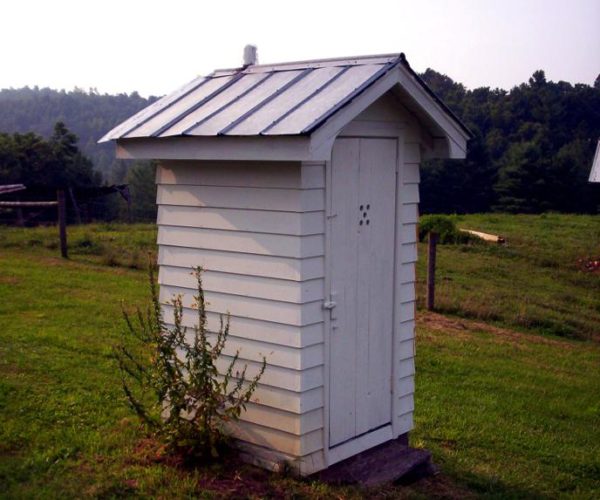
Precautionary measures
Substance belongs to low-hazard (3rd class). Does not burn, does not explode.
The ingestion of a large amount of the drug causes a general toxic effect, indigestion, irritation of the skin and mucous membranes. An ambulance is required.
With competent agricultural work there are no problems. Spraying is carried out in calm weather, in protective clothing, in the respirator "Petal", in gloves. It is necessary to avoid settling of particles in the respiratory tract, as well as on the eyes, skin and mucous membranes. In case of contact, wash with water.
Storage after use
Expiration date in tight packing - without restriction. Opened containers should be protected from moisture, used as soon as possible.
The advantages and disadvantages of the drug
Minuses:
- Severe restrictions on processing time.
- Protective action - no more than a crescent.
- Substance is easily washed away by rain.
- Does not help against bacterial and viral diseases.
- Excessive concentration can destroy (burn) the plant.
- Low concentration is useless.
Positive points:
- Low cost of the drug.
- Long shelf life.
- Good efficacy against fungi.
- Additional iron feed.
- No toxicity (in authorized doses) for plants, humans, or the environment has been identified.
Iron vitriol is deservedly included in the list of sought-after drugs. With proper use, it gives excellent performance in terms of cost / effectiveness, protects planting from diseases and fungi.
